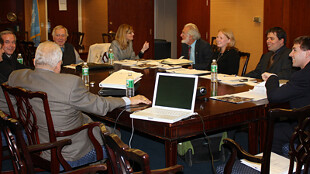Several years ago I wrote a satirical article titled “How not to get a lab job.” In that piece, designed primarily for graduate students who were looking for post-doctoral positions, I tried to use real-life examples based on the types of letters and applications that I received to humorously illustrate what not to do in looking for a position. By all accounts the piece was a big success, and the key focus was to emphasize the importance of professionalism when applying for a position. However, surprisingly (at least to me) I also received complaints that while I was illustrating what not to do, I had failed to help those who truly wanted to learn how to better their chances of finding suitable employment.
With that criticism in mind, and after years of serving on and then chairing a departmental graduate and admissions committee, I now intend to rectify that deficit and provide a semi-comprehensive guide to help graduate students identify desirable mentors for their PhD and successfully secure positions in their laboratories.
Most graduate programs (at least in the US) are designed for advancing directly toward a PhD, without the requirement of obtaining a Master’s degree. And in most cases, students join a department or program, and within the first year or so, are required to set up a number of short trials in host laboratories, usually known as rotations. These rotations typically last anywhere between 6 weeks to several months, depending on the individual program, and provide an excellent experience and window for the prospective student to determine how suitable the mentor (and the lab) is. However, one important point that is too often ignored by students, is that the rotation period also serves as an opportunity for the mentor to observe the student, and in turn, decide upon his/her suitability. In other words, prospective graduate students, beware! Rotations are a two-way street, and you had better look both ways before crossing!
For the purpose of this guide, I will assume that the prospective graduate student has already been accepted into a biomedical research graduate program, and is charged with the task of finding a graduate mentor who will accept him/her into the lab; acceptance into the graduate program is an entirely separate issue and will not be dealt with here.
As noted above, most graduate programs use a rotation system where students need to do trial periods in 3-4 laboratories, and only then can they gain acceptance into one of those laboratories. So obviously, the first task at hand is to find prospective laboratories in which to rotate.
Finding rotations
Since the key to finding a suitable permanent mentor for the PhD depends on first finding suitable rotation options, the identification of good rotation options is a crucial step in the process and cannot be taken lightly. Even students who have homed in on a very specific laboratory that they would like to join and have set up a rotation in that lab should not discount the significance of the other 2 or 3 rotations that they must do, or ‘waste’ them on laboratories that are suboptimal options. Why? For several reasons: the laboratory that the student initially desires may fill up and have no place by the time the student completes his/her rotation, or alternatively, the student may realize that the atmosphere in the lab is not as good as he/she originally thought. Or, the mentor may not be satisfied with the prospective student (even if the student is happy with the mentor). Or there could suddenly be a funding issue and the mentor can’t accept a student at that time. In any case, one never knows the outcome of a rotation in advance, and having reasonable backup opportunities and alternatives is wise. So the optimal situation is to identify 3 or 4 rotations, all with potential—meaning that at least at the outset, each laboratory rotation could lead to selection of a mentor and lab.
What should a student look for in searching for a rotation?
It is my experience that the majority of students at this early career stage do not yet have a very good overview of the different types and wide variety of biomedical research opportunities available. While a small minority may have decided on a specific disease-related focus (for example a type of cancer or heart disease), often for personal/family reasons, when looking for a rotation many students are fairly open to experiencing different research avenues. In my opinion, a common misconception in the search for a PhD laboratory and mentor is that the prospective student often places too much emphasis on the specific scientific research areas of that laboratory. Why is that an error? For several reasons: 1) As noted, students often lack the overview of different scientific research areas to really know in advance if they will like the research or not. I agree that a student who is not particularly interested in physics, chemistry and math will be unlikely to enjoy a structural biology. And obviously a student who knows he/she cannot work with animals should stay away from labs that exclusively do animal studies. But in many other instances, students can find that they like (or dislike) projects unexpectedly. Excitement often comes with greater knowledge of the field, and as students gain independence in their research, they usually become enamored with their selected area of study. However, in contrast, if the atmosphere in the laboratory (or with the mentor) is toxic, usually no matter how interested the student might be in the field, it is unlikely to end well. 2) A PhD project is not likely going to be the area of research that those pursuing academic careers will continue with after their PhD. Most new faculty who come to a university as new assistant professors to start up their own laboratories will bring projects that they begun (and often squirreled away) during the course of their post-doctoral training, not from their PhD training. What is the bottom line? I am suggesting that a student is likely to be happy and succeed in a lab with a good mentor, even if the initial project appears less exciting. This is a key point to consider, and when choosing a mentor, it is important to reflect on the goal of PhD training.
What is the goal of PhD training?
As an idealist, one might say “to gain a greater understanding of the world around us,” and so on. But let’s face it, altruism is hardly at the top of most students’ list of reasons for doing a PhD. Given that the primary reason for enrolling in a PhD program—aside from personal interest, critical thinking skills, communication skills, and everything that comes with learning to be an independent scientist—is to kick-start a career in academia or industry, this leaves us with the next important question: What is the measure of a successful PhD?
Why all this verbiage about the goal and success of a PhD when I am supposed to be providing guidance for how to find and obtain a rotation and PhD mentor? It’s simple: students need to find mentors who are equipped to provide them with the ability to succeed—otherwise that PhD diploma ends up being next to useless. And—not all PhD mentors are equal in that aspect. Not even close. So what is the coin of success and how do students identify it in a prospective mentor?
How do we measure a successful PhD?
This is a question that I asked nearly every applicant to our graduate and admissions program when I was the chairperson. Very few students at that stage were able to communicate an answer that I viewed as realistic. Many would say “I will have learned a lot of techniques.” Others would say “I will be able to run my own lab.” Perhaps the latter answer is a step closer to what I was hoping to hear. I tried to simplify things and ask: “How will a future post-doctoral mentor rate your PhD as successful, if he/she is considering hiring you among other applicants?” Some students would get a little closer to the idea and say “based on my recommendation letters.” Still, very few hit the nail on the head—and this is one reason that I decided to put together this little guide—so that students would be more aware of the real-world expectations of graduate school. The answer, of course, (although there are many versions of this) drills down primarily to one thing: your PRODUCTIVITY, largely assessed by looking at your PUBLICATION RECORD.
For simplicity here, I will avoid getting drawn into difficult arguments over the relative significance of the actual number of papers published, or so-called Impact Factors of the journals in which they are published. Suffice to say that if a student completes his/her PhD with several first-author papers that are published in respected peer-reviewed journals, this is probably the most important stepping-stone to open the doors to top labs for post-doctoral studies. For a student who aspires to an academic career as an independent scientist, acceptance to a top-tier post-doctoral laboratory is the single most important step. Accordingly, this means that for such an aspiring student, the practical goal of a PhD is to position oneself for acceptance to the very top post-doctoral positions.
In a sense, then, the optimal PhD mentor and lab will provide an opportunity for a student to learn, grow, and mature scientifically, develop critical thinking, lab skills and techniques, communication skills (oral and written), but just as importantly, provide an opportunity for the student to excel by publishing first-author research papers in peer-reviewed journals. Published papers are the ‘currency’ of science, and in all likelihood, a student who publishes 3-4 solid first-author papers will have doors open to almost any post-doctoral laboratory. A student who is unproductive will have few options, and those options that remain will likely be with mentors/labs that lead to dead-ends scientifically. In my experience, students who fail to excel in their PhD research are almost never able to “catch-up” and become independent scientists.
So how does one find such a mentor?
It is incumbent on the student to do due diligence and homework to identify such mentors. No mentor will say to a student “Don’t come to me, my students rarely publish—” it is up to the prospective students who are looking for rotation options to do research (remember that word!). How? There are a number of ways: the most simple way is to search the PubMed at the National Library of Medicine. By entering the mentor’s full first and last names, the student can get a readout of all papers published since about 2002. That is long enough—primarily the student should see what has been published in the past 7-10 years. (Note—if the mentor has a very common name, the student will have to search each manuscript and examine the author affiliations to see if the university fits for that mentor, otherwise that paper will be from a different person). It requires effort, as evaluating a mentor’s productivity in this manner needs careful research.
Is my prospective mentor productive and publishing well?
First, just seeing that the mentor has published ~100 papers in this period is not a sufficient measure of productivity. Papers that truly come from the mentor’s lab have the mentor as the senior author, usually the last author on the list, and typically note that the mentor is the corresponding author. If the mentor’s name is placed anywhere else within the paper, or he/she is not the corresponding author, it is probably not really relevant for a prospective student, as it means that the work was a collaboration and (much of) the actual research was done in another lab. Next, the student should make sure that most of the papers are research papers (rather than reviews of the literature). Reviews indicate the mentor is widely known and respected in his/her field, which is a good thing. But if 90% of the papers published in the lab are just reviews, this might be worrisome. Another thing that a student can and should do is try to determine what current students and recent graduates in the lab have published. Most graduate programs have lists of students assigned to individual labs, and many individual labs also have lists of current and former students. My suggestion is to take those lists and very carefully use the PubMed to determine how well these students have published with the prospective mentor. Usually a pattern emerges: in a lab where strong motivated students do extremely well, even average students tend to do well, and most students in such a given are likely to be quite successful. Beware of labs where students publish infrequently.
Another way to evaluate a successful mentor/lab is to see where former students end up. If they have mostly left science, this does not bode well. If the mentor has had the lab long enough, there should be a trail of students who have gone on to excellent post-doctoral positions (searchable on the web with some diligence) and even on to faculty positions, or alternatively, good biotech/industry positions, or other interesting jobs within the scientific community. Often this is listed on lab websites, but can be checked by searching.
Information from current lab members and from other students in the graduate program and institute can also be helpful in filling in the blanks, but it is usually best to complement this information with your own online searches. Students in the lab may be cagey or unwilling to talk freely about their mentor (for fear of retribution or being disloyal). Former students, even if you catch them on the phone, are still dependent on recommendation letters and may be similarly reserved about any criticism of the mentor.
What about funding? Should I ask a mentor if he/she has funding?
Typically a mentor will need to be able to pay for a student’s stipend for the duration of his/her PhD studies, and of course be able to afford chemicals, biological reagents and equipment for the research. However, this is usually not an issue—most departments or programs vet their mentor pools and will only allow mentors with stable funding (or at least a history of stable funding) to recruit a student. So it is certainly worthwhile asking, but usually a program or department will assume responsibility if the mentor runs into trouble. Even in cases where the mentor decides to move to a different institution, procedures are usually in place to find a solution for the student, if he/she does not want to move with the mentor.
What about the differences between large labs and small labs?
When looking for a post-doctoral position that will hopefully later lead to a faculty position, most of the top-tier laboratories will be medium-sized to large. Very few will be small. However, for graduate students, where we are concerned with strong mentorship and a different set of goals, small laboratories can also be outstanding places for a PhD, with potential for much one-on-one mentorship. The key is in the mentorship, and the same criteria apply (productivity, the mentor’s overall commitment to the advancement of his/her students, etc.). In larger laboratories (more that 8-9 people), it would be important for the student to make sure that there are delegated senior people in the lab (post-docs or senior students) to help out in the day-to-day mentorship, because the head of a lab with 20 people will not have the time to discuss research and progress with a new student on a daily basis.
What about new or younger investigators?
New or young investigators can be an excellent choice for a PhD student (in fact, I chose a new investigator and it turned out very well for me). They are usually very ambitious, full of energy and drive, and often spend time in the lab in the early years training personnel and even doing some bench-work before succumbing to administrative duties later on. The only issue is that it is harder to “vet” new investigators, as they do not yet have a track record handling students or even in many cases, publishing as senior authors from their own laboratories. However, the innovative nature of their research and their motivation to succeed usually makes up for the lack of experience and track record.
I have identified a potential mentor who is productive and has successful students—how do I obtain a rotation?
The most important thing in setting up a rotation—and I can’t emphasize this enough—is to be professional! A student who is unprofessional and lazy in approaching a mentor risks losing that rotation. Remember: there may well be pressure on the better mentors, and if it is a “mentor’s market” –meaning the mentor has multiple students who are interested (for what might be a single PhD position)—then students who make a weak first impression might not even be offered a rotation. Again—as students evaluate mentors, mentors are also evaluating students.
Usually the best way to first approach a mentor is with a grammatically-correct and properly spelled email query. It is particularly important to spell the mentor’s name correctly. Put yourself in the mentor’s shoes—if the student who wants to do a PhD in your lab can’t even get your name right, how will he/she be able to get the right chemicals in the right test tubes for the experiments to work? You may be in a hurry, or think that it isn’t important, but believe me—as a mentor—these are crucial points.
The email may be brief, but should ask about a meeting to discuss a potential rotation. While it isn’t necessary to go into minute details about why you are interested in the lab/field, it doesn’t hurt to state that you are interested in XXX or YYY—whatever it is that the lab is working on. But it is better not to expose ignorance than say too little. The conversation with the mentor will be an opportunity to impress him/her with your knowledge.
Once the meeting has been set up, don’t assume that means you automatically have a rotation set up. After discussing potential projects (and make sure to do some basic reading before you meet), it is legitimate and important to ask how the lab works: what the mentor expects from the student both during the rotation and afterward as a full-time PhD student in the lab. Some mentors will say they expect students to work until 7 pm every day. Others are more hands off with regard to time in the lab and vacation. There is a lot of variability, but most mentors expect their students to be as committed as they themselves are to the success of the lab. Make sure you are comfortable with however the lab works.
I found a mentor for my first rotation—can I relax now?
Congratulations on the good work—hopefully you have done your research and vetted your mentor! However, this is not time to relax. To ensure that the mentor will want to offer you a permanent position as a graduate student in the lab once the rotation is completed, it is now crucial to bear down, work very hard and diligently, show that you are interested, responsible, trustworthy, honest, sociable with the other lab members, and capable of great things to come. It is important to realize that your mentor’s time is precious. He/she may be juggling dozens of teaching, administrative and other duties, in addition to mentoring the personnel in the lab. When you have time with your mentor, don’t waste it. Be interested. Ask questions. Learn from him/her. Be eager to show your data, but respect the mentor’s time. I have seen rotation students receive a cell phone call while talking to a mentor (me!), turn their back and walk away to the hall to talk on the phone. As I mentor, I recognize that there can be an urgent call or emergency, but when this quickly became a pattern, it also became quickly apparent to me that if a rotation student that early on didn’t respect me or my time, he/she should find another mentor (who perhaps didn’t care or was far enough removed not to notice). That is precisely what occurred. How else can you impress a mentor? I don’t suggest staying until midnight every night, but every mentor knows that a student who (on a day with no classes) works 9-4 will generally get less done than a student who works 8-7. Be aware that not only the mentor, but the other graduate students, post-docs and even technician in the lab are likely clocking your habits and reporting to the mentor their impressions of you. If you want the job, show that you do! Remember, there may be other students rotating, and perhaps only a single slot open for a PhD position. If you demonstrate that you are the best candidate, you will be offered the position.
Final points:
Remember, a good healthy environment with a mentor who looks after his/her students is crucial. Even if the field isn’t a perfect match with your initial interests, think carefully before turning down such an opportunity for a situation with less mentorship, but what appears to be a more interesting project.
Don’t be discouraged if a specific rotation does not work out as well as intended. That’s what rotations are for: it’s almost like dating, and sometimes it’s just not a good match.
Do your research before approaching mentors for potential rotations; avoid wasting time in labs that are scientific dead ends. Remember, a mentor who is not particularly committed to mentoring can often survive through collaborations—and in some cases by having a lot of funding and personnel. But as a student, what is important is not the overall number of papers published with the mentor’s name on them, but rather the PPP—productivity per person in the lab. A mentor may only publish 2-3 papers a year, but if his/her lab is made up of 2 students and a technician, that is outstanding PPP. Another lab might have 18 people and publish 5-6 papers a year. You make the calculations per person…
Finally, remember that you chose this career to enjoy the work/research. If a mentor or lab environment causes anxiety and stress from Day 1, this is probably only the tip of the iceberg, and I would recommend looking at a different lab.














